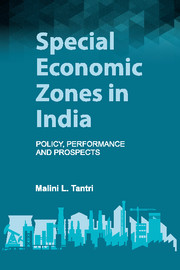Book contents
- Frontmatter
- Contents
- List of Tables, Figures, Charts and Maps
- Preface
- Acknowledgements
- Abbreviations
- 1 Introduction
- 2 Export Processing Zones to Special Economic Zones: Trajectories of Policymaking
- 3 China's Experience with Special Economic Zones under a Liberalized Regime – Highs and Lows
- 4 Performance of Special Economic Zones: Promises, Realizations and Paradoxes
- 5 An Assessment of the Fiscal Viability of Special Economic Zones
- 6 Special Economic Zones and the Question of Efficiency
- 7 Conclusions
- Bibliography
- Index
2 - Export Processing Zones to Special Economic Zones: Trajectories of Policymaking
Published online by Cambridge University Press: 13 September 2017
- Frontmatter
- Contents
- List of Tables, Figures, Charts and Maps
- Preface
- Acknowledgements
- Abbreviations
- 1 Introduction
- 2 Export Processing Zones to Special Economic Zones: Trajectories of Policymaking
- 3 China's Experience with Special Economic Zones under a Liberalized Regime – Highs and Lows
- 4 Performance of Special Economic Zones: Promises, Realizations and Paradoxes
- 5 An Assessment of the Fiscal Viability of Special Economic Zones
- 6 Special Economic Zones and the Question of Efficiency
- 7 Conclusions
- Bibliography
- Index
Summary
Background
SEZs have a long pre-history in the origins and evolution of EPZs, i.e., SEZs are basically the metamorphosis of EPZs, which existed in the Indian economy since 1960s. However, there is a very little in the literature that aims to provide a historical understanding of this evolution and metamorphosis. Explanation for such metamorphosis from EPZs to SEZs could be due to the following: (a) there might have been flaws in the idea behind promotion of EPZs and subsequently in articulating the EPZ policy; (b) there might have been failure in the execution of EPZ policy. These two possible reasons as speculated here are worthy of investigation. Furthermore, how so far the current SEZ policy meets the expectation of policymakers in these two criteria are worthy of exploration. With this background, this chapter attempts a programmatic historical survey of the EPZs/SEZs followed in India in the last five decades (from 1960 till date), focusing especially on the possible reasons that led to the realization on the part of policymakers and the government at large that the existing EPZs require a radical overhauling both in terms of their objectives and the arms that they have been provided in order to bring this objectives into fruition, which in turn led to the transformation of EPZs into SEZs; how far the transformation from EPZs to SEZs is effective at the construction and at the implementation level; what are the problems and prospectus of current SEZ policy. The exercise is based on analysis of various Acts, policy documents, trade reports, government ordinance and regulations and literature on this issue. The rest of the chapter is planned as follows. The next section outlines the evolution of SEZ policy in the country in the last five decades. The section on paradoxes of the current SEZ policy critically evaluates the major loopholes in the current SEZs period and outline prospects and paradoxes of the policy. The last section offers a brief summary.
Metamorphosis from EPZs to SEZ
There exists a close association between the approach followed for setting the economic priorities of the country and the policy evolved for shaping the structure of EPZs/SEZs. It is against this background that the evolution of the SEZ policy in the Indian context is explained here in two phases, stretching over the last five decades.
- Type
- Chapter
- Information
- Special Economic Zones in IndiaPolicy, Performance and Prospects, pp. 11 - 44Publisher: Cambridge University PressPrint publication year: 2016



